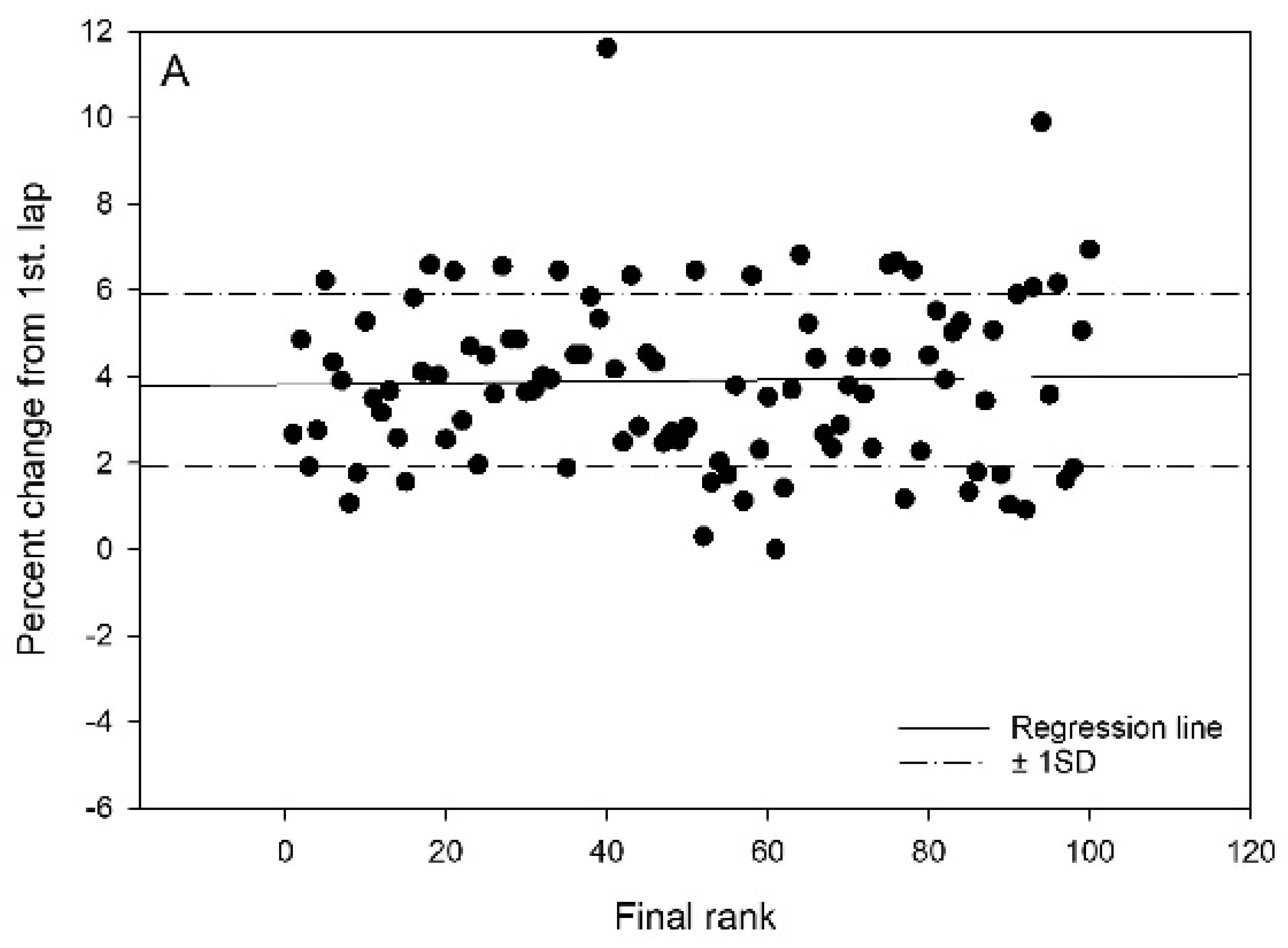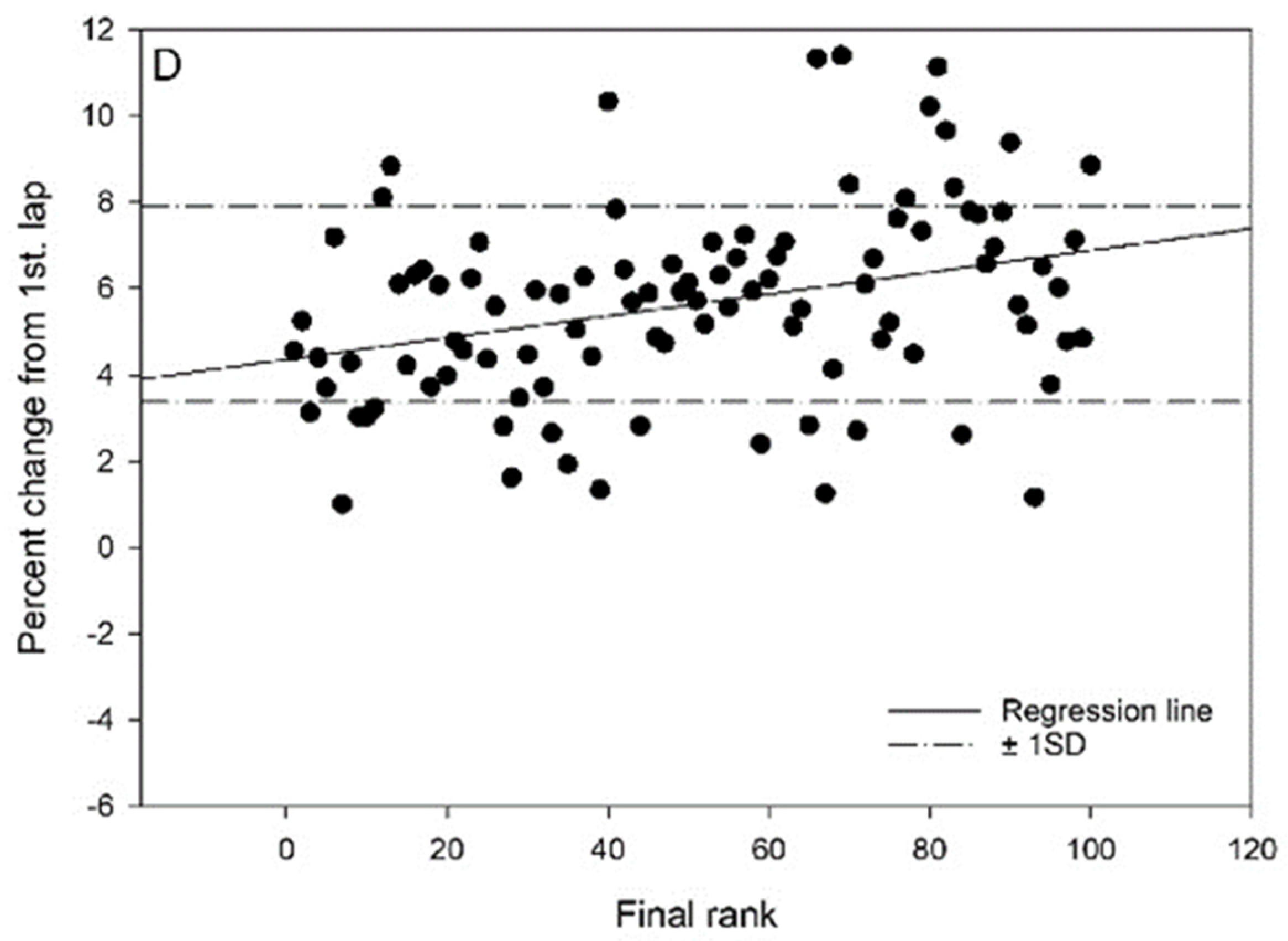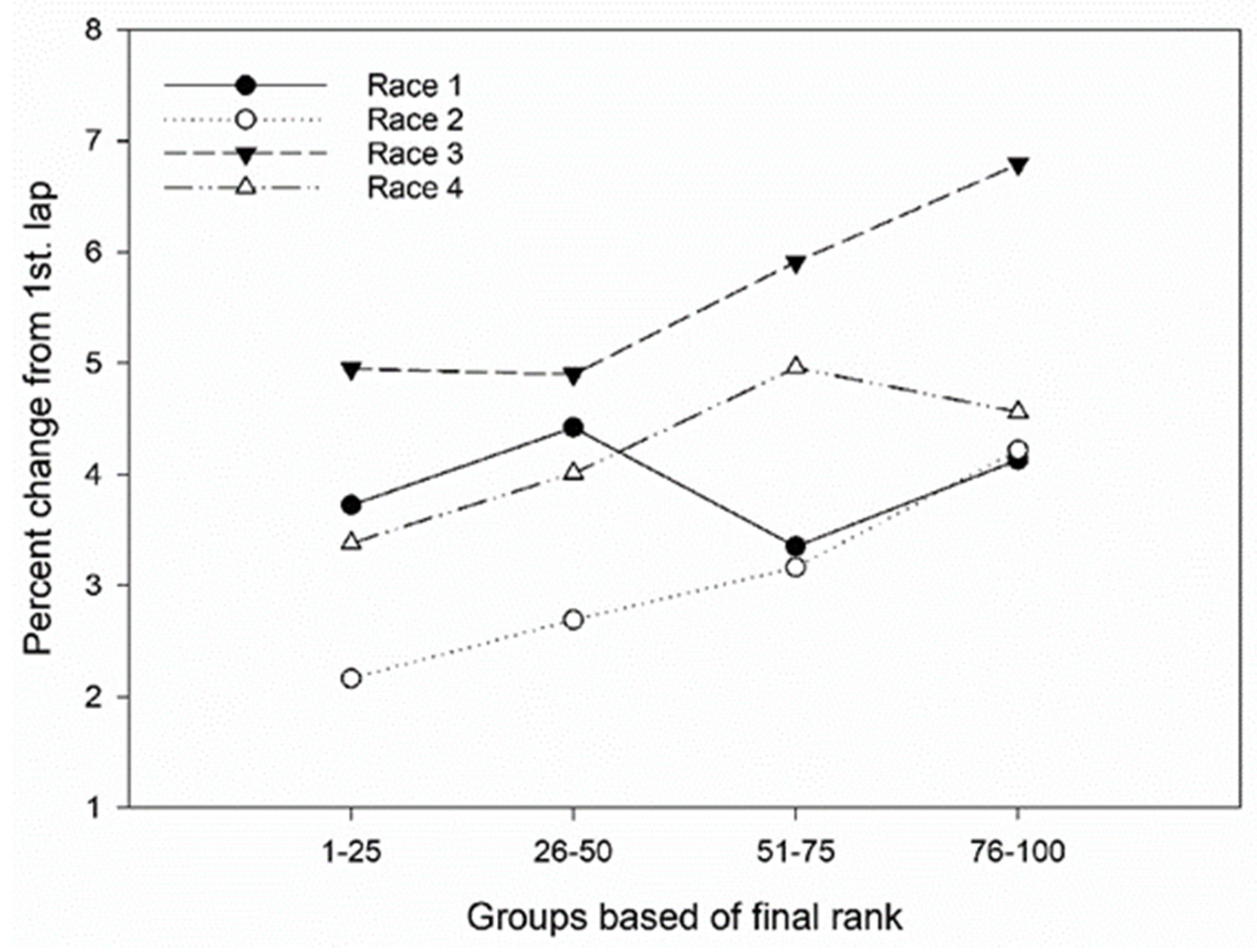Characteristics of Pacing Strategies among Elite Cross-Country Skiers According to Final Rank
Abstract
1. Introduction
2. Materials and Methods
2.1. Experimental Procedures
2.2. Participants
2.3. Course
2.4. Statistical Analysis
3. Results
4. Discussion
5. Conclusions
Author Contributions
Funding
Institutional Review Board Statement
Informed Consent Statement
Data Availability Statement
Conflicts of Interest
References
- Stöggl, T.; Pellegrini, B.; Holmberg, H.C. Pacing and predictors of performance during cross-country skiing races: A systematic review. J. Sport Health Sci. 2018, 7, 381–393. [Google Scholar] [CrossRef] [PubMed]
- Smits, B.; Pepping, G.-J.; Hettinga, F. Pacing and Decision Making in Sport and Exercise: The Roles of Perception and Action in the Regulation of Exercise Intensity. Sports Med. 2014, 44, 763–775. [Google Scholar] [CrossRef] [PubMed]
- Hanley, B. An Analysis of Pacing Profiles of World-Class Racewalkers. Int. J. Sports Physiol. Perform. 2013, 8, 435–441. [Google Scholar] [CrossRef]
- Abbiss, C.R.; Laursen, P.B. Describing and understanding pacing strategies during athletic competition. Sports Med. 2008, 38, 239–252. [Google Scholar] [CrossRef] [PubMed]
- Renfree, A.; St Clair Gibson, A. Influence of Different Performance Levels on Pacing Strategy During the Women’s World Championship Marathon Race. Int. J. Sports Physiol. Perform. 2013, 8, 279–285. [Google Scholar] [CrossRef]
- Williams, E.L.; Jones, H.S.; Sparks, S.A.; Marchant, D.C.; Midgley, A.W.; Mc Naugthon, L.R. Competitor presence reduces internal attentional focus and improves 16.1 km cycling time trial performance. J. Sci. Med. Sport 2015, 18, 486–491. [Google Scholar] [CrossRef]
- Tomazini, F.; Pasqua, L.A.; Damasceno, M.V.; Silva-Cavacante, M.D.; de Oliveira, F.R.; Lima-Silva, A.E.; Bertuzzi, R. Head-to-head running race simulation alters pacing strategy, performance, and mood state. Physiol Behav. 2015, 149, 39–44. [Google Scholar] [CrossRef]
- Konings, M.J.; Schoenmakers, P.P.; Walker, A.J.; Hettinga, F.J. The behavior of an opponent alters pacing decisions in 4-km cycling time trials. Physiol Behav. 2016, 158, 1–5. [Google Scholar] [CrossRef]
- Liedl, M.A.; Swain, D.P.; Branch, J.D. Physiological effects of constant versus variable power during endurance cycling. Med. Sci. Sports Exerc. 1999, 31, 1472–1477. [Google Scholar] [CrossRef]
- Palmer, G.S.; Noakes, T.D.; Hawley, J.A. Effects of steady-state versus stochastic exercise on subsequent cycling performance. Med. Sci. Sports Exerc. 1997, 29, 684–687. [Google Scholar] [CrossRef]
- De Koning, J.J.; Bobbert, M.F.; Foster, C. Determination of optimal pacing strategy in track cycling with an energy flow model. J. Sci. Med. Sport 1999, 2, 266–277. [Google Scholar] [CrossRef]
- Atkinson, G.; Brunskill, A. Pacing Strategies during a Cycling Trial with Simulated Headwinds and Tailwinds. Ergonomics 2000, 43, 1449–1460. [Google Scholar] [CrossRef] [PubMed]
- Swain, D.P. A model for optimizing cycling performance by varying power on hills and in wind. Med. Sci. Sports Exerc. 1997, 29, 1104–1108. [Google Scholar] [CrossRef] [PubMed]
- Sundström, D.; Carlson, P.; Ståhl, F.; Tinnsten, M. Numerical optimization of pacing strategy in cross-country skiing. Struct. Multidiscip. Optim. 2013, 47, 943–950. [Google Scholar] [CrossRef][Green Version]
- St Clair Gibson, A.; Lambert, E.V.; Rauch, L.H.G.; Tucker, R.; Baden, D.A.; Foster, C.; Noakes, T.D. The Role of Information Processing Between the Brain and Peripheral Physiological Systems in Pacing and Perception of Effort. Sports Med. 2006, 36, 705–722. [Google Scholar] [CrossRef]
- Losnegard, T.; Kjeldsen, K.; Skattebo, Ø. An analysis of the pacing strategies adopted by elite cross-country skiers. J. Strength Cond. Res. 2016, 30, 3256–3260. [Google Scholar] [CrossRef]
- Formenti, D.; Rossi, D.; Calogiuri, G.; Thomassen, T.O.; Scurati, R.; Weydahl, A. Exercise Intensity and Pacing Strategy of Cross-country Skiers during a 10 km Skating Simulated Race. Res. Sports Med. 2015, 23, 126–139. [Google Scholar] [CrossRef]
- Welde, B.; Stöggl, T.L.; Mathisen, G.E.; Supej, M.; Zoppirolli, C.; Winther, A.K.; Pellegrini, B.; Holmberg, H.C. The pacing strategy and technique of male cross-country skiers with different levels of performance during a 15-km classical race. PLoS ONE 2017, 12, e0187111. [Google Scholar] [CrossRef]
- Cohen, J. Statistical Power Analysis for the Behavioral Sciences, 2nd ed.; Routledge: New York, NY, USA, 1988. [Google Scholar]
- Losnegard, T.; Tosterud, O.K.; Kjeldsen, K.; Olstad, Ø.; Kocbach, J. Cross-Country Skiers With a Fast-Start Pacing Pattern Increase Time-Trial Performance by Use of a More Even Pacing Strategy. Int. J. Sports Physiol. Perform. 2022, 1–9. [Google Scholar] [CrossRef]
- Colbeck, S.C. A Review of the Friction Of Snow. In Physics of Sliding Friction; Persson, B.N.J., Tosatti, E., Eds.; Springer: Dordrecht, The Netherlands, 1996; pp. 275–291. [Google Scholar]
- Garland, S.W. An analysis of the pacing strategy adopted by elite competitors in 2000 m rowing. Br. J. Sports Med. 2005, 39, 39–42. [Google Scholar] [CrossRef]
- Thompson, K.G.; Haljand, R.; Lindley, M. A Comparison of Selected Kinematic Variables Between Races in National to Elite Male 200 m Breaststroke Swimmers. J. Swim. Res. 2004, 16, 6–10. [Google Scholar]
- Sandals, L.E.; Wood, D.M.; Draper, S.B.; James, D.V.B. Influence of Pacing Strategy on Oxygen Uptake During Treadmill Middle-Distance Running. Int. J. Sports Med. 2006, 27, 37–42. [Google Scholar] [CrossRef] [PubMed]
- Padilla, S.; Mujika, I.; Angulo, F.; Goiriena, J.J. Scientific approach to the 1-h cycling world record: A case study. J. Appl. Physiol. 2000, 89, 1522–1527. [Google Scholar] [CrossRef] [PubMed]
- Diaz, J.J.; Fernandez-Ozcorta, J.E.; Santos-Concejero, J. The influence of pacing strategy on marathon world records. Eur. J. Sport Sci. 2018, 18, 781–786. [Google Scholar] [CrossRef] [PubMed]
- Mattern, C.O.; Kenefick, R.W.; Kertzer, R.; Quinn, T.J. Impact of starting strategy on cycling performance. Int. J. Sports Med. 2001, 22, 350–355. [Google Scholar] [CrossRef] [PubMed]
- Kuzmin, L.; Tinnsten, M. Dirt absorption on the ski running surface—Quantification and influence on the gliding ability. Sports Eng. 2006, 9, 137–146. [Google Scholar] [CrossRef]
- Tucker, R.; Rach, L.; Harley, Y.X.; Noakes, T.D. Impaired exercise performance in the heat is associated with an anticipatory reduction in skeletal muscle recruitment. Pflug. Arch. 2004, 448, 422–430. [Google Scholar] [CrossRef]
- Lima-Silva, A.E.; Bertuzzi, R.C.M.; Pires, F.O.; Barros, R.V.; Gagliardi, J.F.; Hammond, J.; Kiss, M.A.; Bishop, D.J.; Gagliardi, J.F. Effect of performance level on pacing strategy during a 10-km running race. Eur. J. Appl. Physiol. 2010, 108, 1045–1053. [Google Scholar] [CrossRef]
- Atkinson, G.; Peacock, O.; Passfield, L. Variable versus constant power strategies during cycling time-trials: Prediction of time savings using an up-to-date mathematical model. J. Sports Sci. 2007, 25, 1001–1009. [Google Scholar] [CrossRef]
- Ouvrard, T.; Groslambert, A.; Ravier, G.; Grosprêtre, S.; Gimenez, P.; Grappe, F. Mechanisms of Performance Improvements Due to a Leading Teammate During Uphill Cycling. Int. J. Sports Physiol. Perform. 2018, 13, 1215–1222. [Google Scholar] [CrossRef]




| Lap | Mean ± SD | Min–Max | Rank 1–25 | Rank 26–50 | Rank 51–75 | Rank 76–100 | |
|---|---|---|---|---|---|---|---|
| Race 1, classical year 1 | 1st Lap | 824 ± 29 | 762–877 | 788 ± 14 | 812 ± 14 | 840 ± 11 | 855 ± 14 |
| 2nd Lap | 856 ± 31 | 785–918 | 817 ± 13 | 847 ± 9 | 868 ± 13 | 894 ± 10 | |
| 3rd Lap | 855 ± 28 | 790–921 | 817 ± 15 | 849 ± 8 | 869 ± 12 | 886 ± 12 | |
| Race 2, freestyle year 1 | 1st Lap | 702 ± 19 | 658–737 | 678 ± 11 a,c | 701 ± 10 a | 709 ± 11 | 720 ± 13 |
| 2nd Lap | 724 ± 24 | 662–772 | 693 ± 15 | 721 ± 7 | 734 ± 8 | 752 ± 11 | |
| 3rd Lap | 722 ± 24 | 662–777 | 692 ± 17 | 719 ± 11 | 729 ± 9 | 748 ± 13 | |
| Race 3, classical year 2 | 1st Lap | 765 ± 23 | 703–817 | 736 ± 15 a | 764 ± 9 a | 775 ± 13 | 785 ± 15 |
| 2nd Lap | 806 ± 27 | 731–851 | 771 ± 19 | 801 ± 13 | 816 ± 7 | 836 ± 7 | |
| 3rd Lap | 810 ± 28 | 739–872 | 774 ± 18 | 802 ± 10 | 825 ± 14 | 840 ± 12 | |
| Race 4, freestyle year 2 | 1st Lap | 714 ± 22 | 662–759 | 687 ± 11 a,b | 709 ± 13 | 723 ± 8 | 739 ± 9 |
| 2nd Lap | 743 ± 26 | 673–786 | 709 ± 14 | 735 ± 9 | 758 ± 8 | 771 ± 8 | |
| 3rd Lap | 746 ± 27 | 681–797 | 711 ± 16 | 740 ± 11 | 759 ± 11 | 774 ± 11 |
Publisher’s Note: MDPI stays neutral with regard to jurisdictional claims in published maps and institutional affiliations. |
© 2022 by the authors. Licensee MDPI, Basel, Switzerland. This article is an open access article distributed under the terms and conditions of the Creative Commons Attribution (CC BY) license (https://creativecommons.org/licenses/by/4.0/).
Share and Cite
Vikestad, V.; Dalen, T. Characteristics of Pacing Strategies among Elite Cross-Country Skiers According to Final Rank. Int. J. Environ. Res. Public Health 2022, 19, 4589. https://doi.org/10.3390/ijerph19084589
Vikestad V, Dalen T. Characteristics of Pacing Strategies among Elite Cross-Country Skiers According to Final Rank. International Journal of Environmental Research and Public Health. 2022; 19(8):4589. https://doi.org/10.3390/ijerph19084589
Chicago/Turabian StyleVikestad, Vidar, and Terje Dalen. 2022. "Characteristics of Pacing Strategies among Elite Cross-Country Skiers According to Final Rank" International Journal of Environmental Research and Public Health 19, no. 8: 4589. https://doi.org/10.3390/ijerph19084589
APA StyleVikestad, V., & Dalen, T. (2022). Characteristics of Pacing Strategies among Elite Cross-Country Skiers According to Final Rank. International Journal of Environmental Research and Public Health, 19(8), 4589. https://doi.org/10.3390/ijerph19084589






